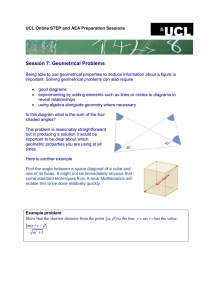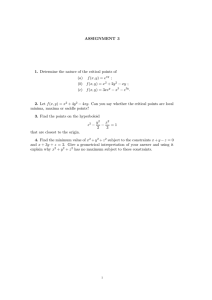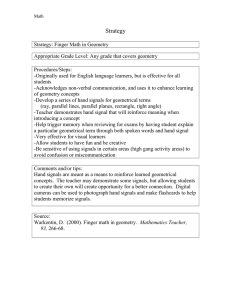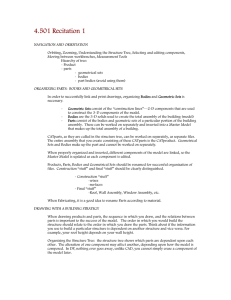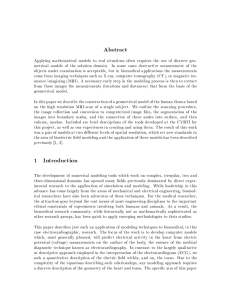Construction of an electrical model of a TQFP100 package with IC
advertisement
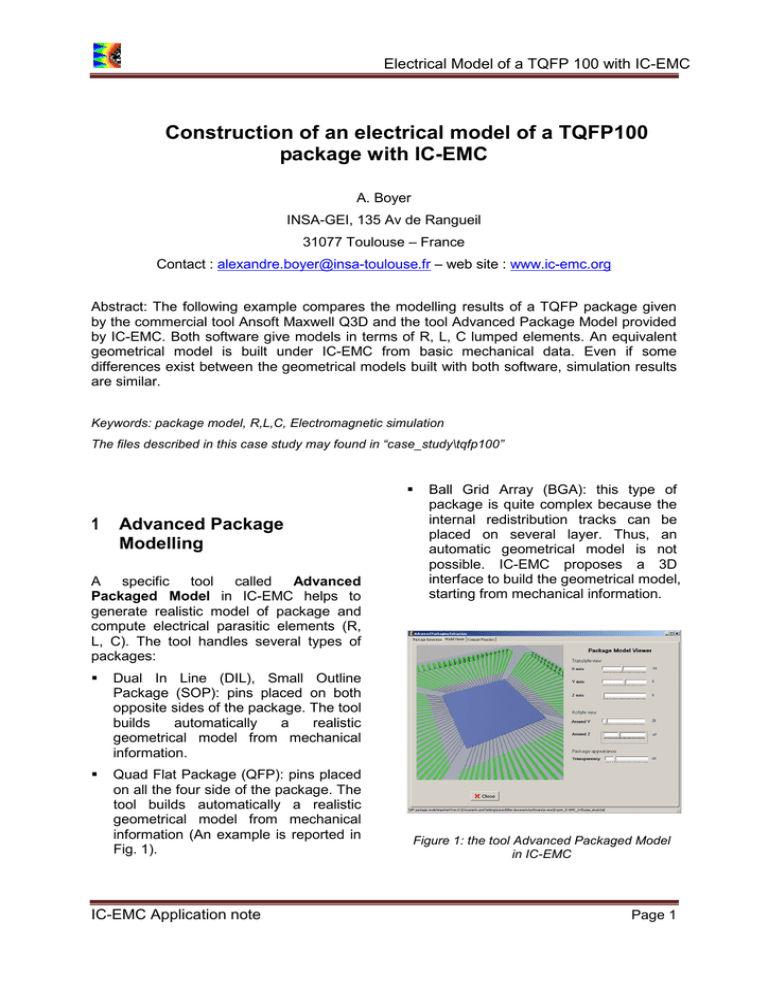
Electrical Model of a TQFP 100 with IC-EMC Construction of an electrical model of a TQFP100 package with IC-EMC A. Boyer INSA-GEI, 135 Av de Rangueil 31077 Toulouse – France Contact : alexandre.boyer@insa-toulouse.fr – web site : www.ic-emc.org Abstract: The following example compares the modelling results of a TQFP package given by the commercial tool Ansoft Maxwell Q3D and the tool Advanced Package Model provided by IC-EMC. Both software give models in terms of R, L, C lumped elements. An equivalent geometrical model is built under IC-EMC from basic mechanical data. Even if some differences exist between the geometrical models built with both software, simulation results are similar. Keywords: package model, R,L,C, Electromagnetic simulation The files described in this case study may found in “case_study\tqfp100” 1 Advanced Package Modelling A specific tool called Advanced Packaged Model in IC-EMC helps to generate realistic model of package and compute electrical parasitic elements (R, L, C). The tool handles several types of packages: Dual In Line (DIL), Small Outline Package (SOP): pins placed on both opposite sides of the package. The tool builds automatically a realistic geometrical model from mechanical information. Quad Flat Package (QFP): pins placed on all the four side of the package. The tool builds automatically a realistic geometrical model from mechanical information (An example is reported in Fig. 1). IC-EMC Application note Ball Grid Array (BGA): this type of package is quite complex because the internal redistribution tracks can be placed on several layer. Thus, an automatic geometrical model is not possible. IC-EMC proposes a 3D interface to build the geometrical model, starting from mechanical information. Figure 1: the tool Advanced Packaged Model in IC-EMC Page 1 Electrical Model of a TQFP 100 with IC-EMC The tool Advanced Packaged Model includes three windows: 1. One interface window Package Generation dedicated to the generation of the geometric model of the package (*.geo file). Figure 2 - External dimensions of the TQFP100 package Introduction PLM# SM033926 / DWG# bd-m0-5716f_a.dwg Package drawing Full nets Target nets 2. One interface window Model Viewer for displaying a 3D picture of the reconstructed package (see Fig. 1). 3. One window Compute Parasitics: resistance, inductance and capacitor of each individual pin of the package. The computation of electrical elements is based on a geometry meshing and a PEEC method. At the end of the simulation, the R,L,C results appear on the screen and may be saved. 2 Package description Full nets Model Ansoft Maxwell Q3D Simulation Tools 100 MHz Analysis frequency RLC matrix included mutual capacitance and inductance Output Results Model Information Package construction TQFP Package Type Lead count 100 Dimension 14 mm x 14 mm Lead pitch Leadframe thickness Wire diameter 0.020 mm (HTS) 0.5 mm 0.127 mm Material properties Properties Material name Rel.permittivity Leadframe - C194 ESH Conductivity (S/m) 3,77E+07 Mold 4 Motherboard 4,4 * Motherboard ground plane is 254 um (10 mil) below the seating plane of the package. Figure 3 - General information of the TQFP100 package Figure 2 describes external dimensions of the TQFP100 package. Figure 3 presents some general information concerning the package, as the bonding wire diameter, the package material, and some simulation parameter of Ansoft Maxwell Q3D. Figure 4 - Details of the lead frame of the TQFP100 package IC-EMC Application note Page 2 Electrical Model of a TQFP 100 with IC-EMC Simualtion Model Lead 100 Lead 76 Lead 1 Lead 75 Figure 6 - Initial screen of the IC-EMC tool Advanced Package Model and input geometrical parameters for the TQFP100 package construction Lead 25 Lead 26 Lead 51 Lead 50 Figure 5 – Complete geometrical model of the package under Ansoft Maxwell 3D Figure 4 provides a detailed view of the lead frame of the package, used for the Ansoft Maxwell Q3D simulation. Figure 5 gives a 3D view of the complete geometrical model used for the Ansoft Maxwell Q3D simulation. It can be noticed that double/triple bonding are used for some lead. 3 Geometrical model construction with IC-EMC The tool Advanced Package Model can build automatically geometrical model for QFP type package from a ten of mechanical parameters. Information concerning external dimensions are given by datasheet. Only information about cavity and die sizes, and pad pitch are not known. IC-EMC Application note Figure 7 - Geometrical model under Ansoft Maxwell Q3D However, approximated values can be deduced from the geometrical model done under Ansoft Mawell Q3D. As the geometrical model built under ICEMC is created automatically, it is an approximated model and is not fully similar to the model of Ansoft Maxwell Q3D. However, the construction of the model is simple and very fast. Page 3 Electrical Model of a TQFP 100 with IC-EMC Open IC-EMC and click on Tools > Advanced Package Model to launch the tool. The following figure details the initial screen used to give basic geometrical data concerning the package. Click on the button Generate Geo Model to build the geometrical model. A dialog box is opened to save geometrical information in a .geo file. Figure 7 compares the geometrical model built with Ansoft Maxwell Q3D (on the left) and ICEMC (on the right). Models are similar. However, some differences exist and the Ansoft Maxwell Q3D model is more complex, especially for lead shape. Moreover, placement of bonding wires is not similar in both models. In IC-EMC, the placement of bonding wires is automatic so they are spread uniformly along the die. The model can also be loaded from the file “\TQFP100.geo” in the field “Geometry File” and by clicking on the button “Import Geo Model”. The 3D geometrical model appears in Fig. 8. 3.1 Configuration Once the geometrical model generated by IC-EMC is validated, the electrical parameter extraction has to be configured. The third window of the tool Advanced Package Model is dedicated to this configuration. Several parameters are configured: • • • • • Placement of an ideal ground plane under the package Height of the package above the ground plane Dielectric constant of the package material Lead frame metal conductivity Frequency of the extraction (for the skin effect) Figure 9 presents the parameters of the simulation. Figure 9 - Simulation parameters Electrical elements to be computed are selected (R, L, C matrix) and the simulation is launched by clicking on the button Compute. 3.2 Figure 8 - Geometrical model under IC-EMC (case_study\tqfp100\TQFP100.geo) IC-EMC Application note Simulation results The simulation time required to extract the R, L, C parameters for the 100 pins of the package does not exceed 22 seconds (on a Intel Core 2 Duo, 2.4 GHz). At the end of the simulation, results are saved in .R, .L and .C files in the form of partial elements matrix. Page 4 Electrical Model of a TQFP 100 with IC-EMC Figure 10 - Partial self inductance of each pin of the package (Min = 3.9 nH, Typ = 4.32 nH, Max = 5.11 nH) Figure 12 - Partial capacitor of each pin of the package (Min = 0.69 pF, Typ = 0.78 pF, Max = 0.9 pF=) Min, Typ and Max value are given in the header of these files. They are also given on the Compute Parasitics windows. Figures 10 to 12 present the simulation results. The different partial elements (R, L, and C) computed by IC-EMC can be found in the following files: Figure 11 - Resistance of each pin of the package (Min = 124 mΩ, Typ = 138 mΩ, Max = 161 mΩ) 4 4.1 TQFP100.L: partial inductance matrix TQFP100.C: partial capacitance matrix TQFP100.R : serial resistance of package pins Comparison with Ansoft Maxwell Q3D results Inductance extraction Figures 13 and 14 compare the extraction results of partial inductance (self and mutual inductances respectively) for the 25 first pins as the IC-EMC geometrical model is symmetrical. IC-EMC Application note Page 5 Electrical Model of a TQFP 100 with IC-EMC Figure 13 – Comparison of self inductance results provided by both model Figure 15 – Comparison of resistance results provided by both model 4.2 Resistance extraction Figure 15 compares the resistance extraction results provided by IC-EMC and Ansoft Maxwell Q3D. IC-EMC provides resistance values similar to those given by Ansoft Maxwell Q3D. However, some discontinuities in the Ansoft Maxwell Q3D appears, which are due to the presence of double or triple bonding on some pins. This type of bonding is not modelled with IC-EMC. Figure 14 – Comparison of mutual inductance results provided by both model Results of self inductance provided by ICEMC are very similar to those given by Ansoft Maxwell Q3D. However, there are differences for mutual inductances; ICEMC tends to under estimate mutual inductance. They are certainly due to differences in geometrical models. Separation between leads is smaller in Ansoft Maxwell Q3D model than in IC-MC model. 4.3 Capacitance extraction Figures 16 and 17 compare results of partial capacitance extraction (only the 25 first pins). Both software gives similar results. The same conclusion as inductance extraction can be formulated. IC-EMC tends to under estimate mutual capacitor between neighbour pins. It can be also noticed that mutual inductance values given by IC-EMC are systematically positive as the tool provides only absolute value. Figure 16 – Comparison of capacitances results provided by both model IC-EMC Application note Page 6 Electrical Model of a TQFP 100 with IC-EMC Figure 17 – Comparison of mutual capacitance results provided by both model Differences between geometrical models can explain these discrepancies. 5 Conclusion This application note has shown an example of modelling of a package with the tool Advanced Package Model of ICEMC. Results provided by IC-EMC are compared with those given by a commercial tool, Ansoft Maxwell Q3D, in order to validate IC-EMC. Both software give electrical models in terms of lumped electrical parameters (R, L, C partial elements). Results given by both tools are similar. Some differences exist especially for mutual inductances and capacitances. These differences can be explained by the differences of geometrical models. As ICEMC reconstructs a geometrical model automatically from a reduced set of parameters, it can not create a geometrical model as accurate as the one construct manually under Ansoft Maxwell Q3D. However, the automatic construction is very fast and simple which can compensate the slight loss of accuracy for an estimation of package electrical model. IC-EMC Application note Page 7
